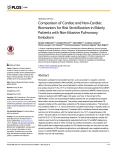-
Články
- Časopisy
- Kurzy
- Témy
- Kongresy
- Videa
- Podcasty
Risk of Allergic Rhinitis, Allergic Conjunctivitis, and Eczema in Children Born to Mothers with Gum Inflammation during Pregnancy
Purpose:
Despite links between maternal and child health status, evidence on the association between gum infection in pregnant mothers and childhood allergies is scarce. We aim to evaluate the risk of developing allergy in children born to periodontal mothers in a nationwide study.Methods:
We conducted a 9-year population-based, retrospective cohort study using Taiwan’s National Health Insurance database. A study cohort of 42,217 newborns born to mothers with periodontal disease during pregnancy was identified in 2001 and matched with 42,334 babies born to mothers without any infection (control) by mother’s age at delivery and baby sex. With a follow-up period from 2001 to 2010, we observed the incidence of allergic rhinitis (AR), allergic conjunctivitis (AC), and eczema in these children. Cox proportional hazards regression models were performed with premature deaths as competing risk for the estimation of allergic disease risks.Results:
Nine-year cumulative incidences were the highest among children born to periodontal mothers; they reached 46.8%, 24.2%, and 40.4% (vs. 39.5%, 18.3% and 34.8% in control) for AR, AC, and eczema, respectively. Our results showed moderately increased risks for the allergies in children born to periodontal mothers relative to their matched non-inflammatory control (adjusted HRs: 1.17, 95% CI: 1.15–1.20; 1.27, 1.24–1.31; 1.14, 1.12–1.17, respectively). Because the impact of food consumption and living environment cannot be considered using insurance data, we attempted to control it by adjusting for parental income and mother’s residential area.Conclusions:
Overall cumulative incidence and risks of children born to periodontal mothers for AR, AC, and eczema are significantly higher than those born to non-inflammatory mothers. Gum infection in women during pregnancy is an independent risk factor for allergic diseases in children, thus its intergenerational consequences should be considered in gestational care.
Autoři: Vivian Chia-Rong Hsieh 1; Chin-Chen Liu 2; Yu-Chen Hsiao 3; Trong-Neng Wu 4,5,6*
Působiště autorů: Department of Health Services Administration, College of Public Health, China Medical University, Taichung, Taiwan 1; Department of Family Medicine, E-Da Hospital, Kaohsiung, Taiwan 2; Center for General Education, Asia University, Wufeng, Taiwan 3; Department of Nursing, College of Medicine and Nursing, Hungkuang University, Taichung, Taiwan 4; Division of Environmental Health and Occupational Medicine, National Health Research Institutes, Zhunan, Taiwan 5; Department of Healthcare Administration, Asia University, Wufeng, Taiwan 6
Vyšlo v časopise: PLoS ONE 11(5)
Kategorie: Research article
prolekare.web.journal.doi_sk: https://doi.org/10.1371/journal.pone.0156185© 2016 Hsieh et al. This is an open access article distributed under the terms of the Creative Commons Attribution License, which permits unrestricted use, distribution, and reproduction in any medium, provided the original author and source are credited.
The electronic version of this article is the complete one and can be found online at: http://journals.plos.org/plosone/article?id=10.1371%2Fjournal.pone.0156185Souhrn
Purpose:
Despite links between maternal and child health status, evidence on the association between gum infection in pregnant mothers and childhood allergies is scarce. We aim to evaluate the risk of developing allergy in children born to periodontal mothers in a nationwide study.Methods:
We conducted a 9-year population-based, retrospective cohort study using Taiwan’s National Health Insurance database. A study cohort of 42,217 newborns born to mothers with periodontal disease during pregnancy was identified in 2001 and matched with 42,334 babies born to mothers without any infection (control) by mother’s age at delivery and baby sex. With a follow-up period from 2001 to 2010, we observed the incidence of allergic rhinitis (AR), allergic conjunctivitis (AC), and eczema in these children. Cox proportional hazards regression models were performed with premature deaths as competing risk for the estimation of allergic disease risks.Results:
Nine-year cumulative incidences were the highest among children born to periodontal mothers; they reached 46.8%, 24.2%, and 40.4% (vs. 39.5%, 18.3% and 34.8% in control) for AR, AC, and eczema, respectively. Our results showed moderately increased risks for the allergies in children born to periodontal mothers relative to their matched non-inflammatory control (adjusted HRs: 1.17, 95% CI: 1.15–1.20; 1.27, 1.24–1.31; 1.14, 1.12–1.17, respectively). Because the impact of food consumption and living environment cannot be considered using insurance data, we attempted to control it by adjusting for parental income and mother’s residential area.Conclusions:
Overall cumulative incidence and risks of children born to periodontal mothers for AR, AC, and eczema are significantly higher than those born to non-inflammatory mothers. Gum infection in women during pregnancy is an independent risk factor for allergic diseases in children, thus its intergenerational consequences should be considered in gestational care.
Článok vyšiel v časopisePLOS One
Najčítanejšie tento týždeň
2016 Číslo 5- Metamizol jako analgetikum první volby: kdy, pro koho, jak a proč?
- Masturbační chování žen v ČR − dotazníková studie
- Role praktického lékaře v rozpoznání, diagnostice a léčbě depresivní poruchy
- Autismus u dětí matek užívajících SSRI v těhotenství?
- Komunikační karty v přednemocniční neodkladné péči
Najčítanejšie v tomto čísle- Comparison of Cardiac and Non-Cardiac Biomarkers for Risk Stratification in Elderly Patients with Non-Massive Pulmonary Embolism
- Risk of Allergic Rhinitis, Allergic Conjunctivitis, and Eczema in Children Born to Mothers with Gum Inflammation during Pregnancy
Prihlásenie#ADS_BOTTOM_SCRIPTS#Zabudnuté hesloZadajte e-mailovú adresu, s ktorou ste vytvárali účet. Budú Vám na ňu zasielané informácie k nastaveniu nového hesla.
- Časopisy



